Sig Fine-Tunes the Smallest Blowback Action Pistol
In 2019 Sig did what no airgun manufacturer had done before, they designed a Micro Compact blowback action CO2 pistol with a self-contained CO2 BB magazine. That in itself, sold a lot of guns, but in order to make a CO2 pistol this small, one that could use a 12 gram CO2 cartridge, meant that there were some big hurdles for the Sig Sauer’s Sig Air Division engineers to clear. Back in the summer of 2019, Sig Air’s Product Manager Dani Navickas, said that “Sig likes to challenge their R&D engineers, so it was actually a challenge to the R&D team to completely replicate the [9mm] P365 in 1:1 scale so it would be a great training tool. It had to be an equal.” In all of those respects the CO2 model achieved its goals, as I proved in my comparison between the CO2 model and the 9mm pistol last year, but the air pistol nevertheless fell a little short of (consumer) expectations in velocity, and its small size had some unforeseen complications. The first series of P365 models were nevertheless impressive for their authenticity to the 9mm Sig and accuracy with .177 caliber BBs out to 21 feet. For such a small air pistol the precision handling all but made up for the gun’s minor shortcomings.

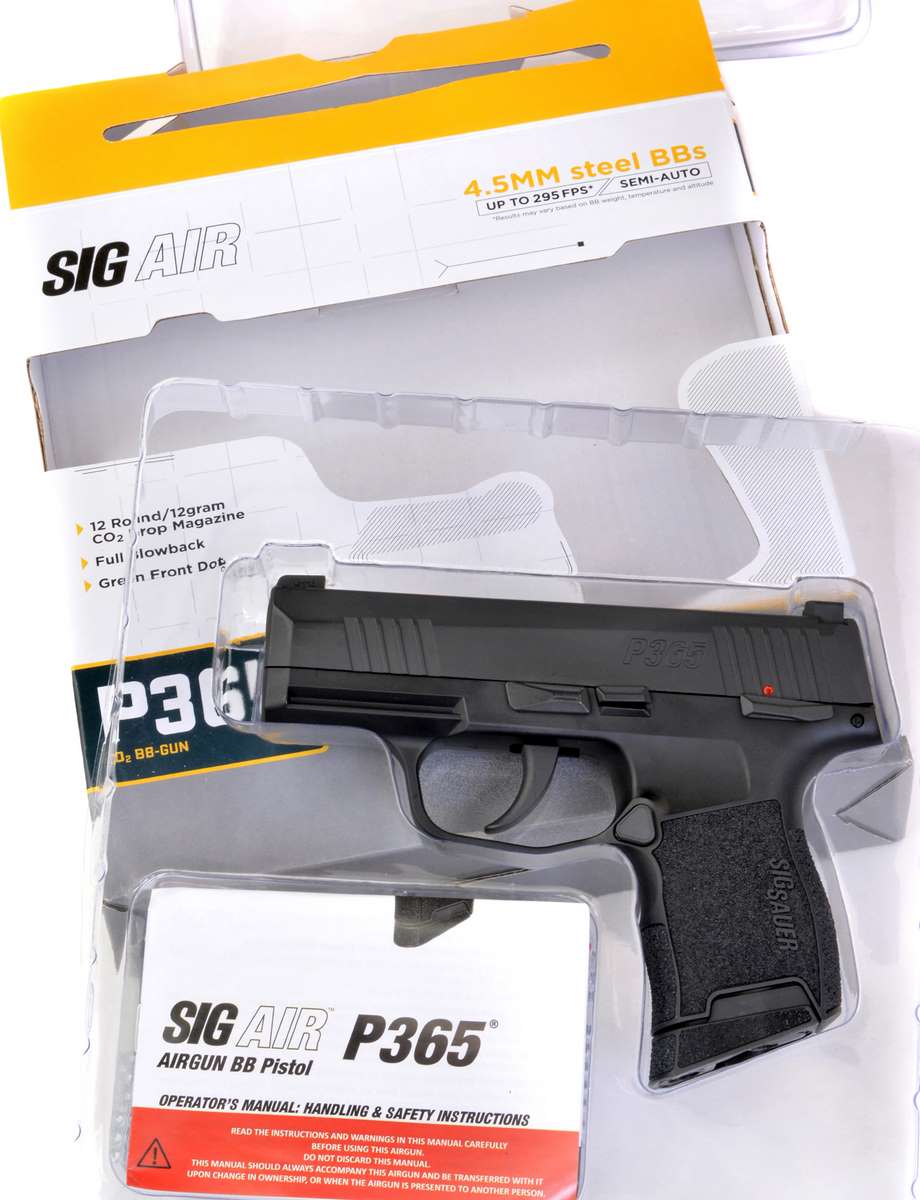
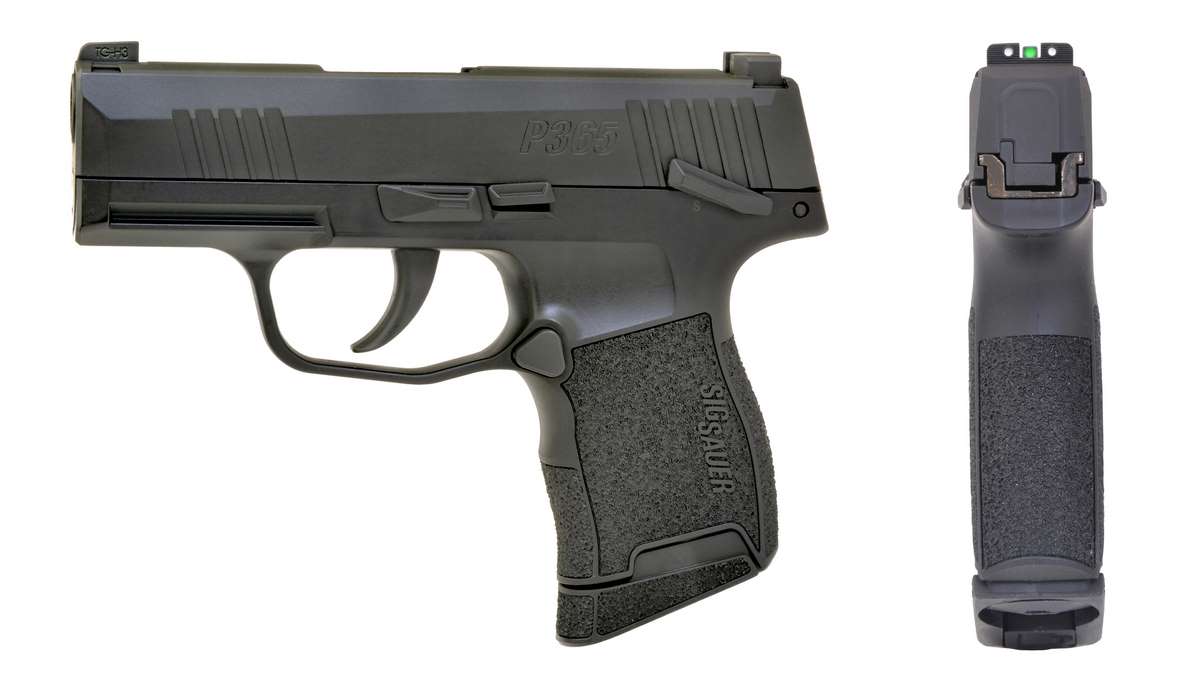
Fine-Tuning
Engineers and designers, especially in the world of firearms, being people who strive to do new things or to improve existing things, are never ones to leave well enough alone, and in Sig Air’s R&D department, where feedback from reviewers (journalists) and consumers was taken seriously, the P365 was generating questions about its performance and handling, that Navickas and her team were dedicated to addressing. The P365 models currently in production for 2020 are improved over last year’s guns in small, but meaningful ways.
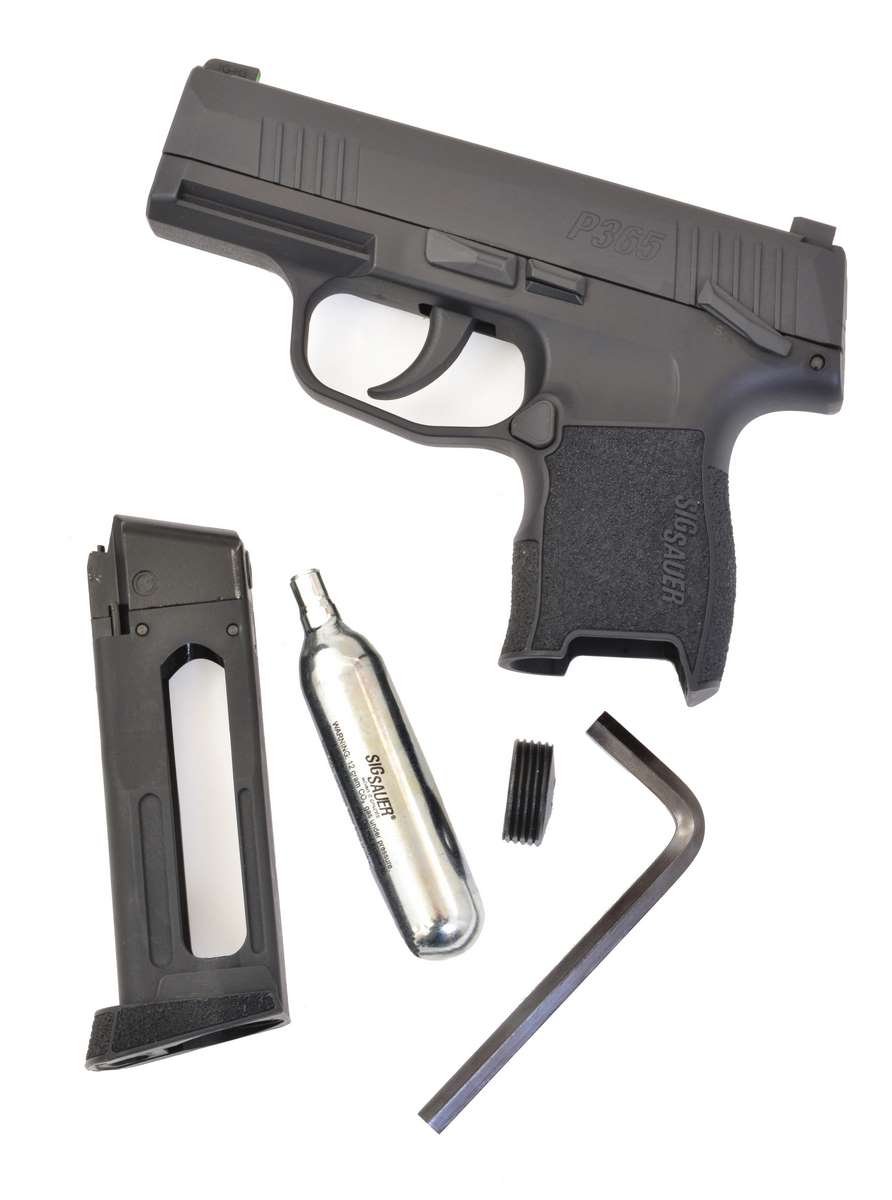
Not P365 2.0
This isn’t about a new model, let’s say for example, the Umarex Walther PPS and PPS M2, where there are multiple changes to the gun’s (and air pistol’s) design and handling; the changes to the Sig Sauer P365 CO2 model is more about fine tuning the 2020 models to improve performance and handling within the same design.
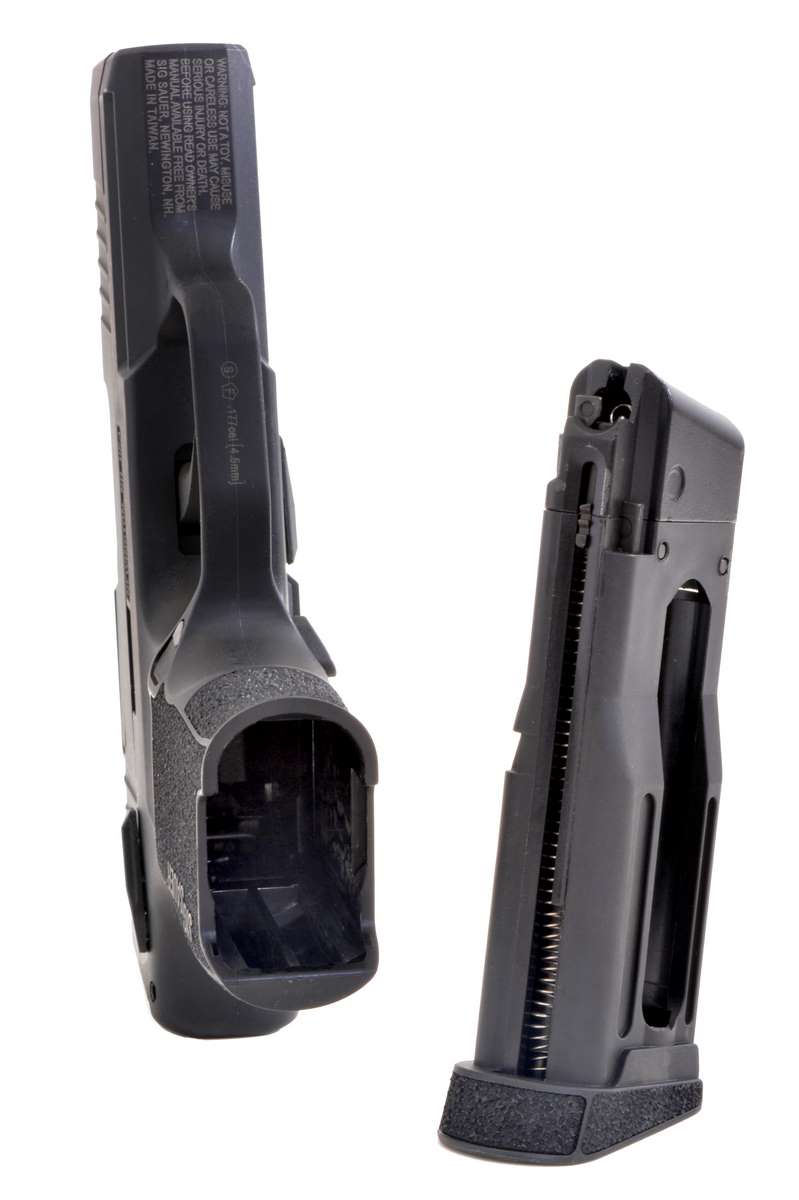
One of the things I had pointed out was that due to its small size the CO2 cooled the gun every time you fired it. This lowered pressure and allowed liquid to escape into the ports. The compounding issue was the remarkably small size of the CO2 BB magazine which limited gas chambering and porting, thus making the pistol more sensitive to temperature swings. This, however, had shown no appreciable effect on the gun’s accuracy during my series of tests, but rather on the consistency of function and blowback action. Similar comments arose among consumers and Sig Air engineers addressed this with improvements to the porting and balance of the valve resulting in a P365 air pistol that is now “…less temperature sensitive and with a bit more blowback pep,” according to Sig Sauer.
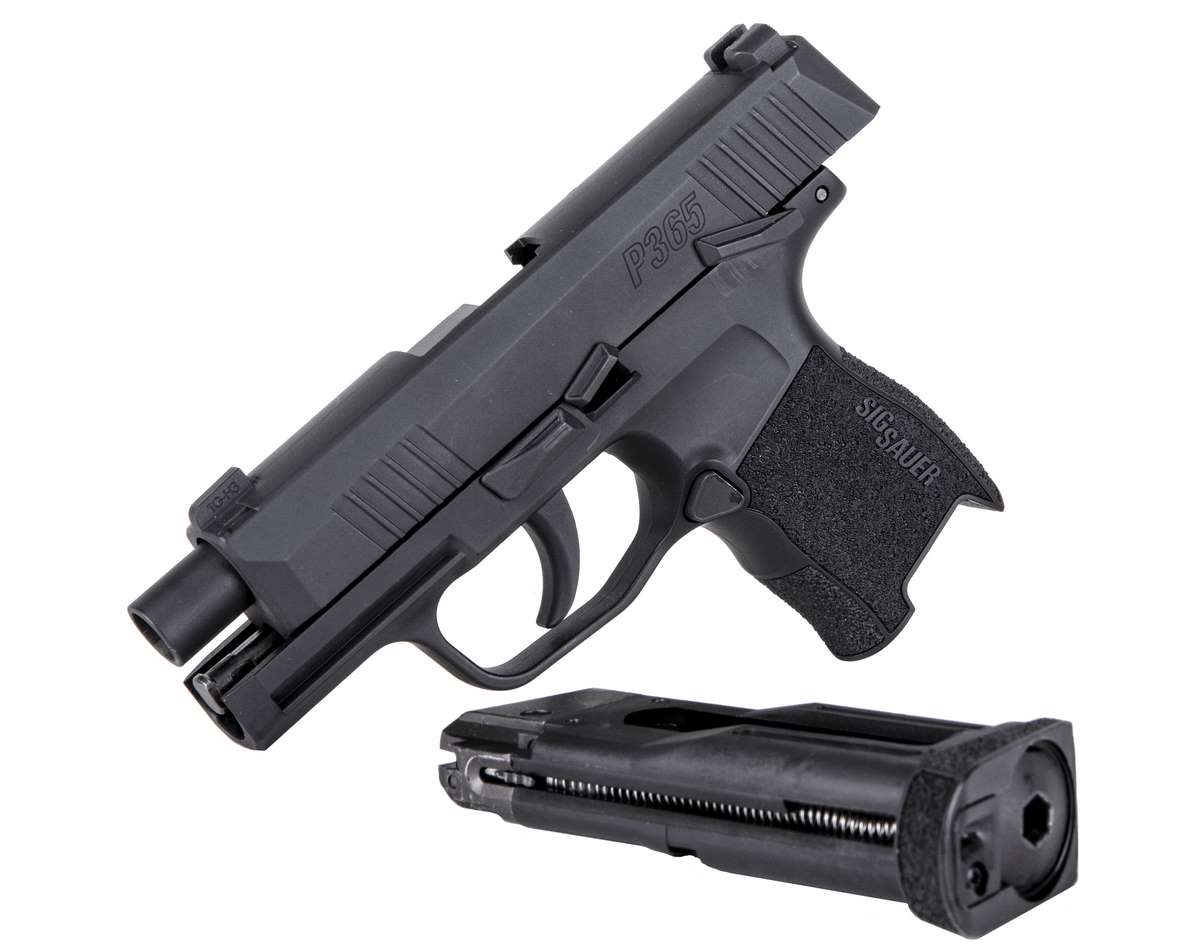
In doing this there was the potential to create a new problem with more force being applied against internal parts, and Sig’s engineers “…decided to tinker with some of the internals on the slide to improve durability and increase the life expectancy of the pistol.” The latter is a big deal, as I’ll explain. Since the P365 CO2 model still cannot be field stripped, these are internal changes you will have to feel, rather than visually inspect. Sig Sauer engineers did, however, have a way to proof their design modifications by subjecting the CO2 model to the same endurance tests, using the same endurance test fixtures as the 9mm model. That means that the latest CO2 pistol design was put through “10,000… 15,000… and even 30,000…cycles and still fired just fine.” I doubt many of us will put 30,000 BBs through the gun.
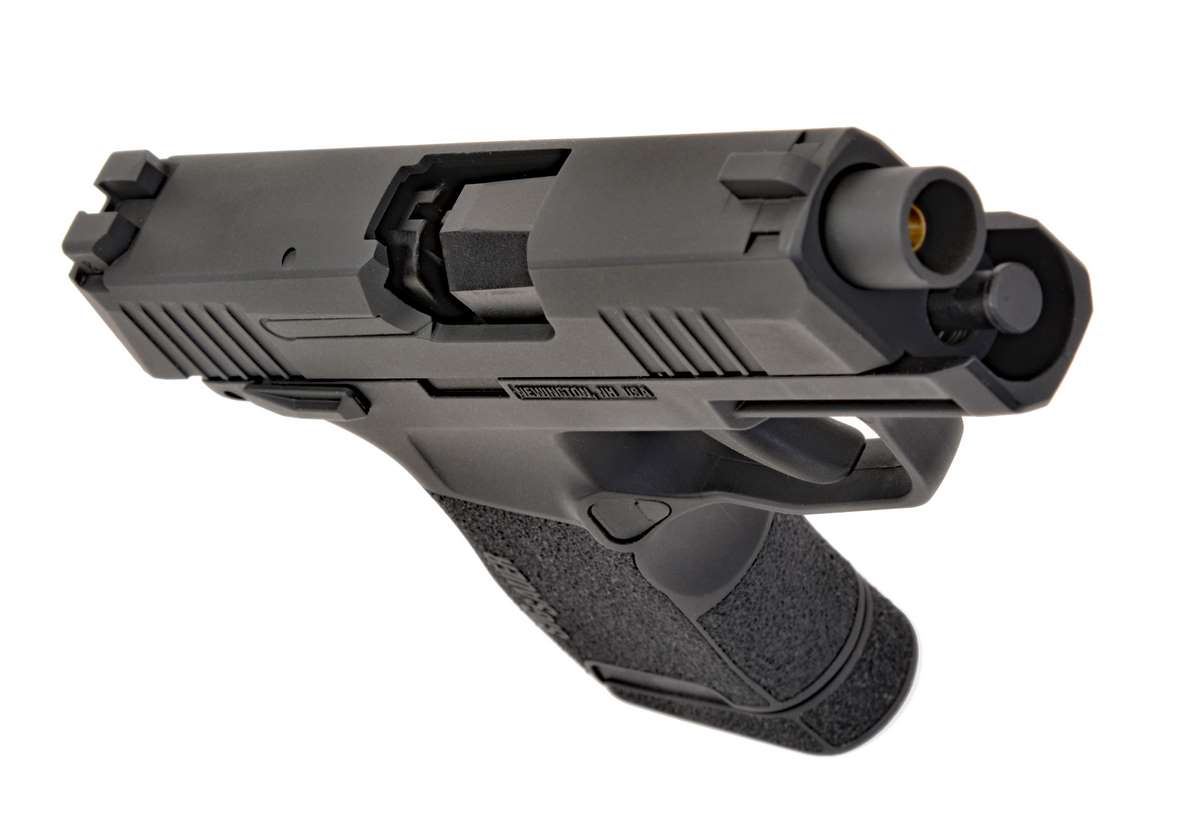
Not Done Yet
The barrel tolerances were improved to increase compatibility with a wider variety of ammo and provide better accuracy across the board. Considering the original test gun was printing 1-inch to 1.5-inch groups at 21 feet with a 3.25 inch barrel, and putting at least five of 10 rounds into groups as small as 0.5 inches, the new model can only go from strength to strength.
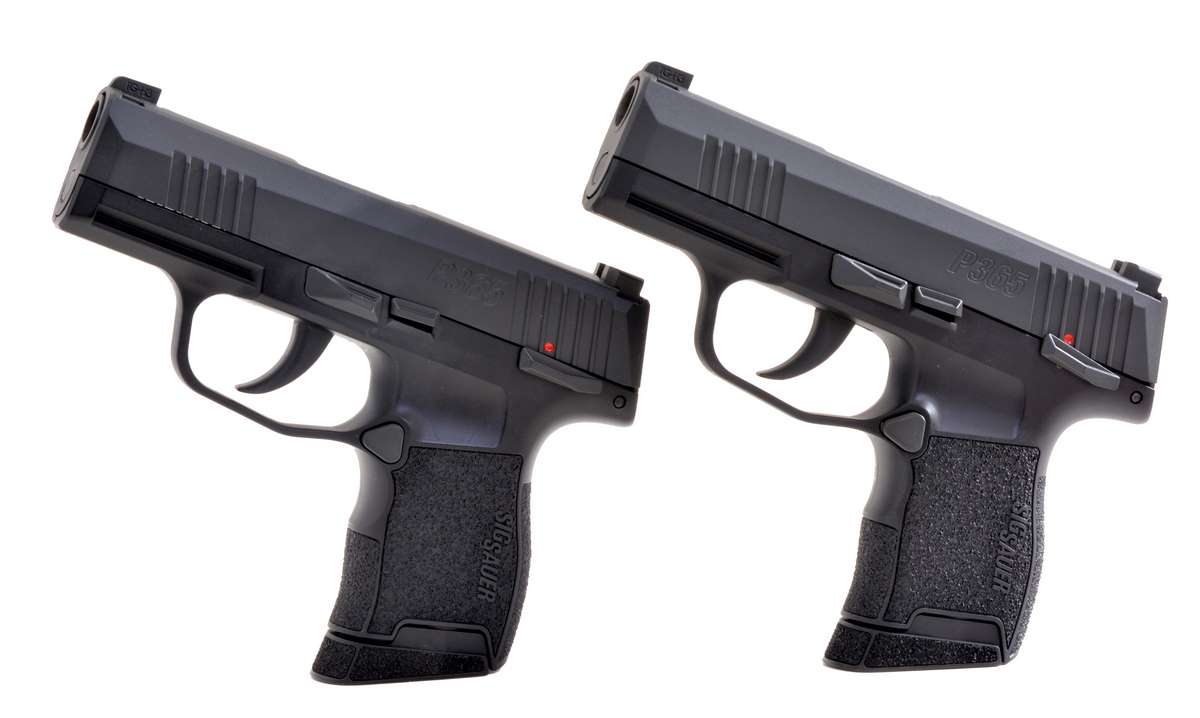
There was one other recurring complaint involving the smoothness of the trigger pull. On the original test gun from 2019’s reviews, trigger pull was a short but firm 5 pounds, six ounces, with 0.3125 inches of total take up to a crisp break. The trigger moved back 0.25 inches with almost zero resistance, and from there was a very firm 0.125 inches to discharge, with no over travel and a quick reset. While heavy in terms of total resistance through the last 0.125 inches of pull, the total trigger pull compared favorably with the centerfire pistol’s 6 pound average, which is also moved back 0.25 inches with almost zero resistance, before a firm pull through of 0.25 inches to break the shot. The trigger on 2020 CO2 models has been improved with some extra polishing here and there to make it feel as close to the 9mm model as possible.
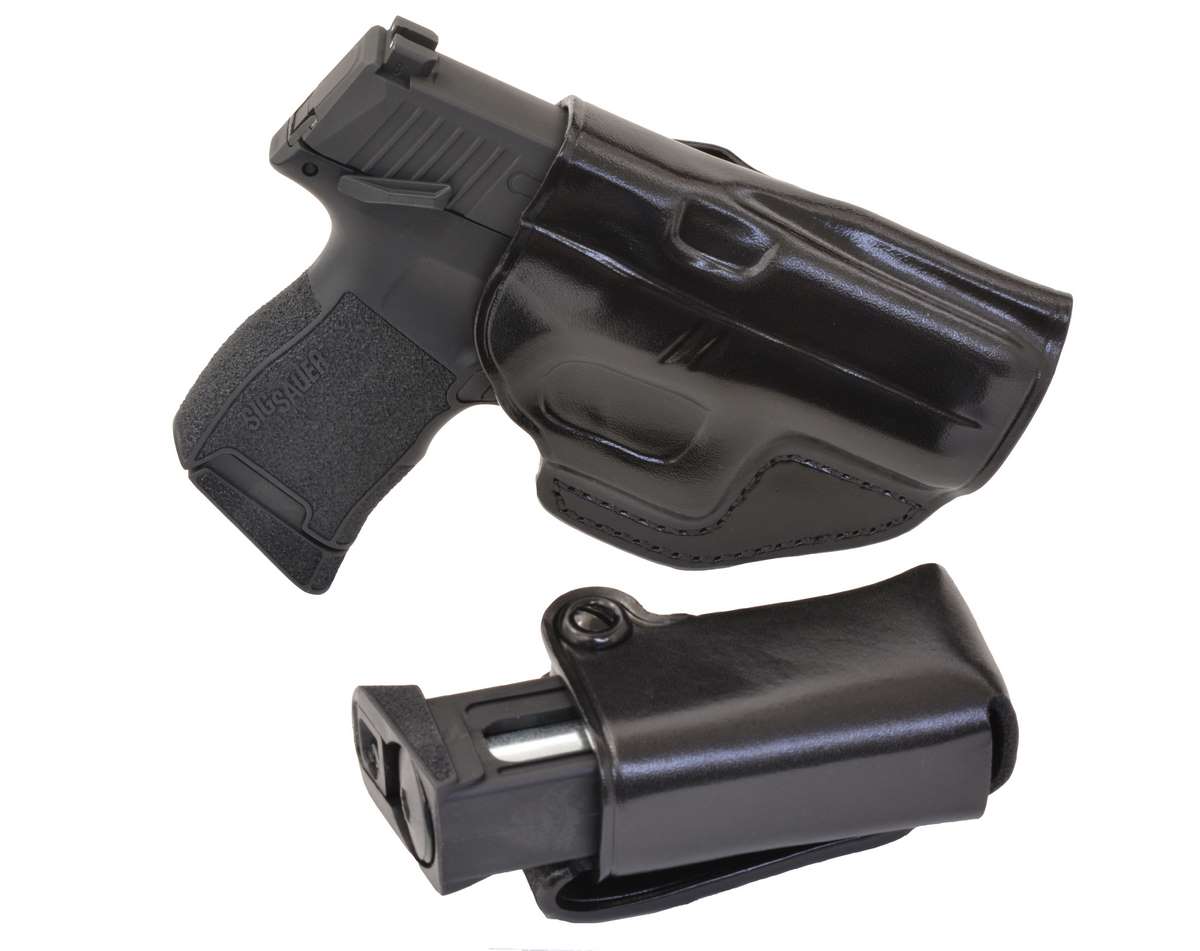
The Smallest 9mm Pistol’s Understudy
As someone who has carried handguns of all sizes for over 30 years it is hard to look at the Sig Sauer P365 and not be amazed at its size. I have carried .380s that are larger. And the .380 is an ideal place to start for comparison. Looking at this from a purely handgun perspective (with CO2 training guns in mind), one of the more popular .380s for concealed carry today is the Glock 42.

I carried one for a while and then reverted back to my custom built Ruger LCP. Why, because the Ruger (mine being the red trigger model) has a capacity of 7 rounds (6+1), the same as the Glock 42, but is smaller and more comfortable to carry.
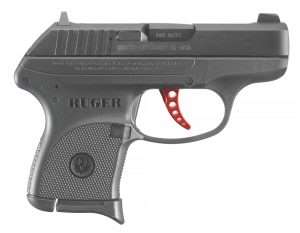
The Ruger has a 2.75 inch barrel, the Glock a 3.25 inch barrel, so that accounts for some of the difference. But these are not for shooting targets; they are for saving your life in a close quarter confrontation, rarely beyond 21 feet and often as close as 10 feet or less. Barrel length isn’t going to matter too much. Matching CO2 models are ideal for training for this purpose. Many of you will never carry a centerfire pistol, or own one, but the overall purpose of CO2 models like the new Sig Sauer P365 is to offer that capability, as well as provide an air pistol for sport shooting. The size of the Sig falls into a category populated by smaller caliber handguns.
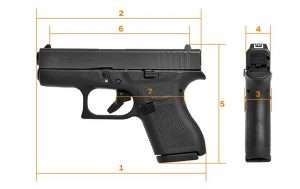
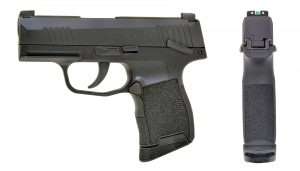
Today’s modern personal defense ammunition (Federal Premium Personal Defense and Sig Sauer Elite Performance V-Crown, as an example) make the .380 a very effective caliber, but still not as effective for self defense as a comparable 9mm round. Now, Sig Sauer makes some excellent .380 pistols in their P238 series (similar in size and operation to a Colt Mustang .380) as well as the P938 models in 9mm (single stack, 6-round magazines), so they know how important it is to build a 9mm that is as close as possible to the size of a .380 for superior personal defense use.
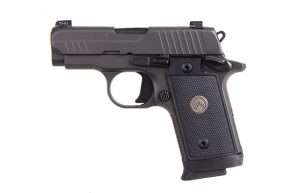
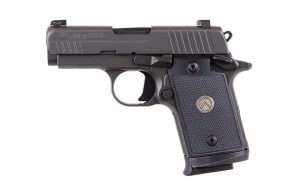
When you can have a 9mm that is barely larger than a .380, and I am talking very little difference overall, you would probably select the 9mm over the smaller caliber pistol, even if it had the same capacity. But let’s add some Sig Sauer magic and give that gun a 10+1 capacity. Add impressive sights, ease of handling, ambidextrous manual safeties, light carry weight, a contoured frame and impressive grip design and magazine combination that allows a firm grasp, and you have a multiple Handgun of the Year winner.
Sig Sauer’s SIG AIR Division knew the P365 was going to be an out of the gate winner for CCW and backup pistol use across the board, groundbreaking designs that work tend to go that way, and they wanted to be able to offer a matching CO2 model for training and for CO2 air pistol enthusiasts who want a blowback action pistol that is identical to its centerfire counterpart; a CO2 powered, .177 caliber understudy, and that is exactly what we are talking about.

How does this play out in centerfire guns? Consider 10+1 capacity in 9mm with an overall length of 5.8 inches, a width of 1-inch, a height of 4.3 inches (with the flush magazine, 4.5 inches with finger extension) and a weight of 17.8 ounces empty. The tradeoff in weight for having a 9mm is negligible compared to the .380 ACP Glock (15.87 ounces vs. 17.8 ounces), and almost half a pound compared to the little Ruger .380 ACP at 10.6 ounces, which is hard to beat. But in overall size, the differences are more revealing as shown in the photos; 5.94 inches for the Glock vs. 5.8 inches for the P365 (smaller) and 5.17 inches for the Ruger. For height, the Ruger is smallest at 3.71 inches but the Glock at 4.13 inches vs. the Sig at 4.3 inches is pretty close. The Sig is the widest at a mere 1.0 inches (at its widest point) compared to the Glock at 0.98 inches. The Ruger is smaller overall, but is a .380. And as for CO2 counterparts for training or sport shooting with BBs, there are no Glock 42 or Ruger LCP air pistols. Sig Sauer has scored bullseyes in both the centerfire and CO2 categories with the P365.
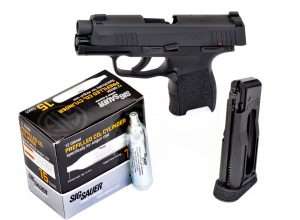
How Did They Do That?
SIG AIR knew the production schedule for the P365 9mm model and wanted to have a matching 1:1 CO2 model ready. Considering the unique design of the centerfire pistol, and its compact double stack magazine, allowing the 10+1 capacity, the typical solutions for making an air pistol would not allow a 1:1 CO2 model. There is also an extended capacity 9mm mag for the P365 that increases the length of the grip and holds 12 rounds, and that is the reason why the CO2 model loads 12 BBs and not 10. But SIG AIR did not want to compromise the exterior dimensions by pulling the old extended capacity magazine trick.
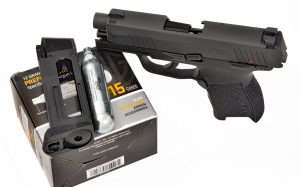
To put the designs in perspective, you have to start with the idea that the mechanisms in a centerfire or rimfire pistol utilizing a firing pin to strike a cartridge primer, ignite the gun powder in the shell and send the bullet down the barrel cannot be duplicated in a CO2 pistol, because the gun itself, through the CO2 system, has to provide the ignition to propel the BB or pellet down the barrel. CO2 mechanisms take up space in the frame and within the CO2 BB magazine. In every case a larger handgun like a 1911 allows this to work within the same size pistol. As guns get smaller the problem of making everything fit increases exponentially. The solution for most is to use extended capacity-style magazines that will allow more room for the CO2 mechanism. And that’s how it has been done up to this point, except for some older designs like the Umarex Walther PPK/S, where the grip frame is just a little longer than the centerfire pistol’s. With few exceptions this has also required the use of a stick magazine. To do what SIG AIR has done in building a 1:1 CO2 version of the P365 9mm pistol required a clean sheet of paper and 18 months of design work to rethink how a blowback action CO2 mechanism and self-contained CO2 BB magazine could be scaled down to fit, and still use a standard 12 gr. CO2 cartridge.
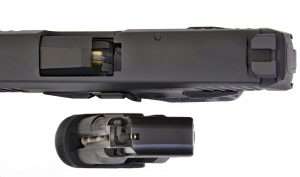
SIG AIR’s Product Manager Dani Navickas explains that “Sig likes to challenge their R&D engineers, so it was actually a challenge to the R&D team to completely replicate the P365 in 1:1 scale so it would be a great training tool. It had to be an equal.”
The quick fix to making a CO2 pistol this compact was to use a smaller 8 gr. CO2 cylinder, but the goal was to end up with a design that used a full size 12 gr. CO2. “The 12 gr. [cylinder] scale is basically the size of the P365 CO2 BB magazine, so everything had to be designed around that. This was really breaking new ground,” says Navickas. She explains that in order to make it work “…you have to start shaving off every fraction of an inch and designing parts that can do the same job but take up less space. The valve for the magazine is unique in its design and is at a slight angle to save a little extra space. The interface of the barrel breech with the BB magazine is a completely different design than anyone has ever used.” Looking at the gun up close you can see they actually lock together, and the spring-loaded BB stop, which prevents BBs from falling forward until the magazine is loaded into the pistol, is pushed out of the way by the back of the barrel as the magazine locks into place.
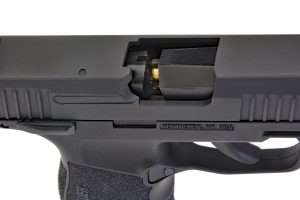
The new 9mm and CO2 P365 design is based on the larger P320, while Sig Sauer’s earlier Micro-Compact 9mm and .380 ACP models (P938 and P238) were based on the old Colt Mustang .380 SAO, hammer-fired, design, itself derived from the Colt Model 1911.
The firing system for the P365 CO2 model is integrated into the frame (a similar concept to the recent P320/M17 ASP pellet model), and this utilizes an internal striker-like mechanism to actuate the valve and release the CO2 when the trigger is pulled. The P365 CO2 design acts like a striker fired pistol. Striker style air pistols actually use a small internal hammer to hit the release valve so they are still hammer fired, but the SIG AIR design does not. It is “closer to a striker firing system than a hammer firing system” and it is also smaller, again working with the rest of the firing system and CO2 BB magazine design to maintain the correct centerfire pistol dimensions.
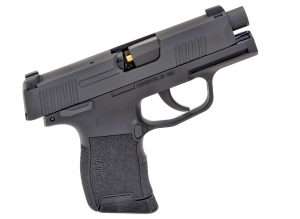
There is one minor concession to scaling down the internal mechanisms, it requires a fixed barrel rather than a short-recoil, locked-breech, tilting-barrel design like the centerfire model and other high end blowback action CO2 pistols, and this is evident when the slide locks back because the barrel remains level. This also precludes field stripping the gun, though SIG AIR says that the gun can be disassembled but not the same way as the centerfire pistol. There is no mention of this in the instruction book and SIG AIR does not recommend taking the CO2 model apart. “To meet the R&D goals, and have a self-contained CO2 BB magazine, it was more important to get the handling, operating features and size correct, than to be able to fieldstrip the gun,” explains Ed Schultz, SIG AIR’s Engineering Manager.
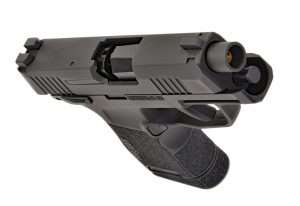
The blowback travel of the slide is very close to the centerfire pistol’s but when the slide locks open on the empty magazine, or if you manually lock it open, it rests further forward on the frame due to the close interface and locking mechanism of the barrel and magazine. “There is a fun factor to being able to fieldstrip a CO2 model,” admits Schultz, “but for the P365, it isn’t so much a tradeoff as it is necessary to get the external dimensions right and have a self-contained CO2 BB magazine that is barely larger than the CO2 cartridge it holds.” This is the smallest blowback action air pistol there is. By any measure of achievement, SIG AIR’s R&D team met the challenge.
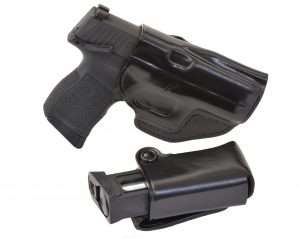
A word about safety
Blowback action airguns provide the look, feel and operation of their cartridge-firing counterparts and this is one reason why they have become so popular. Airguns in general all look like guns, blowback action models more so, and it is important to remember that the vast majority of people can’t tell an airgun from a cartridge gun. Never brandish an airgun in public. Always, and I can never stress this enough, always treat an airgun as you would a cartridge gun. The same manual of operation and safety should always apply.

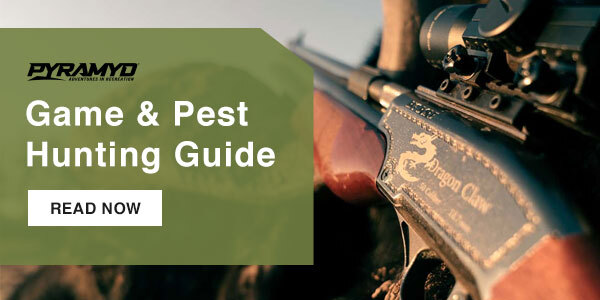
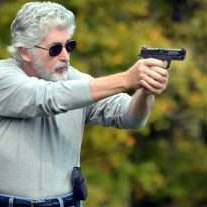
The 380 like your Ruger and my Colt Mustang Pocketlite are being relegated to the job formerly done by a 25 acp Pocket Pistol, backup or carrying when nothing else fits your dress or lifestyle.Pistols like the Walther Ppk, Ppk/s are relegated to the historical status. 21-24 ounce blowback 380 just not in the running for carry pistols. I suspect the PpK series like the classic Browning High Power will soon be discontinued, maybe replaced by a similar looking polymer striker fired version version weighing 13-14 ounces. Glock is in trouble with their competition to the Sig. The 26 is chubbier , the 43 holds only 6 rounds and the newX extended grip version is a pathetic attempt to respond to the Sig. My bet is Glock will need a thinner version of the 26 to be competitive.. Didn’t thinkI would want a polymer pistol, but I picked up a Glock 19 to pair with my Ruger PC9 Carbine. Was waiting for the Sig with ambi safety and now it is here. Like the idea of a pistol you drop in a pocket to have a safety, also like that you can unload with the safety engaged. Anyone picking up the 9 mm version should have the co2 version. Would have like velocity in the 330-350fps range, but the barely 300 will make it a 7 yard practice pistol. Sig still has to be admired for what they have done here with this little pistol. Who dares, wins